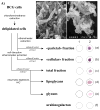The immunomodulatory lipoglycans, lipoarabinomannan and lipomannan, are exposed at the mycobacterial cell surface
- PMID: 18539533
- PMCID: PMC2613510
- DOI: 10.1016/j.tube.2008.04.002
The immunomodulatory lipoglycans, lipoarabinomannan and lipomannan, are exposed at the mycobacterial cell surface
Abstract
By labeling surface carbohydrates, we found that a pool of lipoglycans, cell wall associated, is exposed at the cell surface of mycobacteria and thus, most probably, inserted in the outer leaflet of the outer membrane. In contrast, plasma membrane anchored lipoglycans are not accessible to surface labeling. This result supports the role of lipoglycans as key immunomodulatory molecules but raises the question of their transport from the plasma membrane, where they are synthesized, to the outermost layers of the envelope, where they can act as modulins. The data are discussed in terms of consequences for cell envelope organization.
Figures



References
-
- Chatterjee D, Khoo KH. Mycobacterial lipoarabinomannan: an extraordinary lipoheteroglycan with profound physiological effects. Glycobiology. 1998;8:113–20. - PubMed
-
- Nigou J, Gilleron M, Puzo G. Lipoarabinomannans: from structure to biosynthesis. Biochimie. 2003;85:153–66. - PubMed
-
- Briken V, Porcelli SA, Besra GS, Kremer L. Mycobacterial lipoarabinomannan and related lipoglycans: from biogenesis to modulation of the immune response. Mol Microbiol. 2004;53:391–403. - PubMed
-
- Sutcliffe I. Lipoarabinomannans--structurally diverse and functionally enigmatic macroamphiphiles of mycobacteria and related actinomycetes. Tuberculosis (Edinb) 2005;85:205–6. - PubMed
-
- Gilleron M, Jackson M, Nigou J, Puzo G. Structure, biosynthesis, and activities of the phosphatidyl-myo-inositol-based lipoglycans. In: Daffé M, Reyrat JM, editors. The Mycobacterial Cell Envelope. Washington, DC: ASM Press; 2008. pp. 75–105.
Publication types
MeSH terms
Substances
Grants and funding
LinkOut - more resources
Full Text Sources

